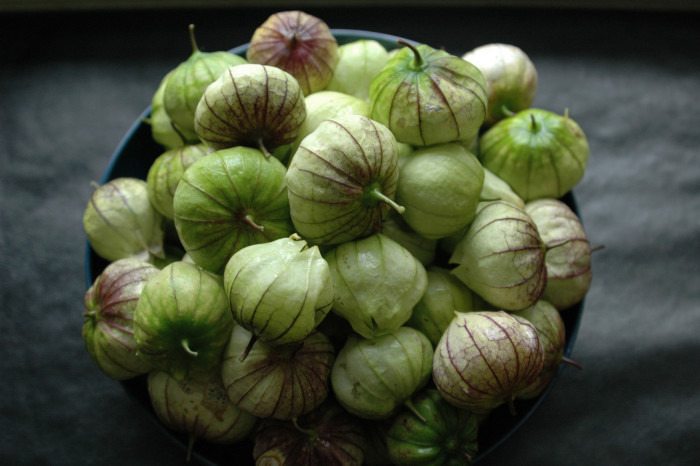What's In Season In October: Lettuce, Tomatillos And Sesame Seeds
It's a busy time for chef Eric Skokan. Not only does the chef run two restaurants, Black Cat and Bramble & Hare, in Boulder, but he works his 130 acres of farmland every day to supply them and his farmers' market stand with the most local produce any cook dreams of. "October is the month of embarrassment of riches. It's pretty spectacular the variety of things that we are harvesting," the chef says. "At some point in October we have our first big frost, but until then all the plants we planted in the summer are still alive and growing." As he harvests the tail end of the peppers, eggplants and tomatoes, Skokan looks forward to the rise of mizuna, tomatillos and sesame seeds, which most people don't realize grow in Colorado.

Tomatillo
"We are harvesting tomatillos like mad and making a variation on green chili with confit pork shoulders that get cooked overnight," says Skokan. "I like the acid in tomatillos a lot, so I think of them as a way to add acidity to a dish that might need it." To do this, the chef-cum-farmer discards the fruit's papery-thin coat before roasting and pureeing the lime-green flesh. Then he simply adds the mash to whatever might need a little jump-start of flavor and brightness, like his heirloom bean ragu. "It's a stick-to-the-ribs, rich and hearty dish, and I find adding tomatillo is a really great way to freshen it up," he says. Another way to use this nightshade is in salsa, either as the star of the dish or mixed with a classic tomato base. Keep in mind that though "tomatillo" sounds like "tomato," they don't taste the same, and when you're shopping for this ingredient in the farmers' market make sure to get firm, bright green specimens, preferably with their brown husks intact.
Ruby Streaks Mizuna
Though this leafy purple plant doesn't look like much, one bite and you will understand the sharp, horseradish bite that is mizuna. Right now if you find this lettuce it will prove plenty spicy. But almost as if by magic, over the course of October it will lose potency and become lighter with a flavor profile similar to its cousin, arugula. "It gets better as the temperature gets colder," says Skokan, who uses the stronger leaves as a garnish and to spike side dishes. "When the heat goes down a bit, it has a pleasant pepperiness and rich sweetness as well." This makes it a shoe-in for salads or placed under a lovely fillet of local fish. Use it as you would arugula or another spicy mustard green, and when looking for mizuna in the store go for fresh leaves that aren't wilted and don't have dark brown spots.
Sesame Seeds
Normally one doesn't think of Colorado when one contemplates sesame seeds, but maybe we should, thanks to Skokan. He discovered that they grow well here almost by accident, and today he starts the process of harvesting the flowering plant come early October. It takes about two or three weeks before they are ready for processing, and once done, guests at Black Cat get treated to possibly the best tahini in the country. "They are best right when they are harvested, as they impart a nuttier flavor and a buttery texture," says the chef, adding that this makes a tahini that is "creamy and light and wonderful." In season, Skokan adds this fresh sesame paste to just about everything. "I like to put it straight on the plate to add a rich umami flavor, mix it into smoked eggplant and create a version of za'atar with fresh herbs." He will then add it to roasted potatoes or grilled lamb — just about anything he can. If you see bags of fresh sesame seeds, don't hesitate to buy. Even if you can't use them up right away, you can store them in an airtight container like you would any spice, and they are still good even if they don't impart a superb richness like the just-harvested seeds do.

